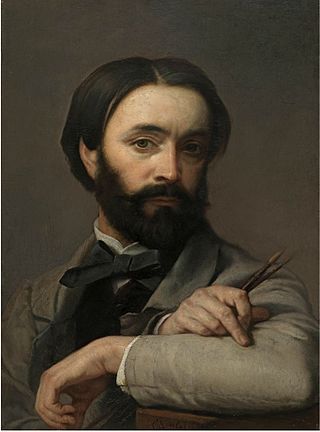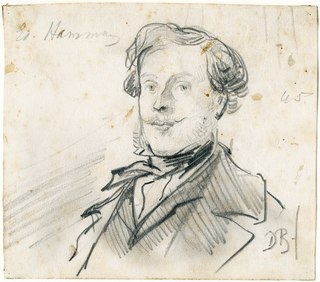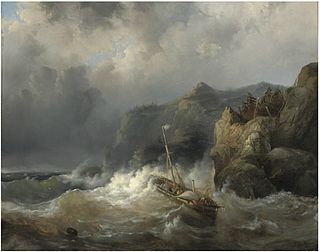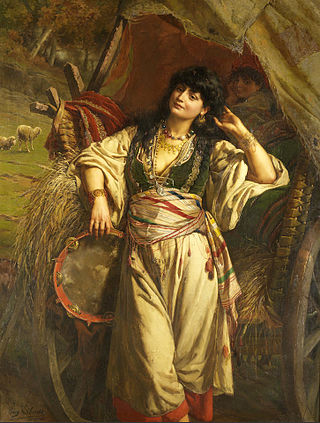
Henri Leys, Hendrik Leys or Jan August Hendrik, Baron Leys was a Belgian painter and printmaker. He was a leading representative of the historical or Romantic school in Belgian art and became a pioneer of the Realist movement in Belgium. His history and genre paintings and portraits earned him a European-wide reputation and his style was influential on artists in and outside Belgium.

Jan Verhas or Jan Frans Verhas was a Belgian painter of the Realist school. He was known for his portraits and genre paintings often depicting children of the Belgian bourgeoisie. Jan Verhas also painted history paintings, coastal landscapes, beach scenes, seascapes and the occasional still life of flowers. He was an important representative of the Realist movement in Belgium.

Nicaise de Keyser was a Belgian painter of mainly history paintings and portraits who was one of the key figures in the Belgian Romantic-historical school of painting.

Charles Verlat or Karel Verlat was a Belgian painter, watercolorist, engraver (printmaker), art educator and director of the Antwerp Academy. He painted many subjects and was particularly known as an animalier and portrait painter. He also created Orientalist works, genre scenes, including a number of singeries, religious compositions and still lifes.

Karel Ooms was a Belgian painter of portraits, genre paintings and history paintings. He was also known for his Orientalist scenes and Oriental landscapes.

Ferdinand de Braekeleer, sometimes spelled as Ferdinand de Braeckeleer, was a Flemish painter and printmaker. He is known for his paintings of genre scenes, church interiors, historic events, religious scenes, cityscapes, market scenes and market still lifes. He is called 'the Elder' to distinguish him from his son with the same name, who was also a painter.

Edouard Jean Conrad Hamman was a Belgian painter and engraver who specialized in portraying scenes from the lives of famous artists, scholars and the nobility.

Eugène Joors, was a Belgian painter in the realistic style.

Egide Linnig or Egidius Linnig was a Belgian painter, draughtsman and engraver who is best known for his marine art and occasional genre scenes. He was one of the first realist engravers in Belgium.

Hendrik Frans Schaefels or Henri François Schaefels, also known as Rik Schaefels, was a Belgian Romantic painter, draughtsman and engraver known for his seascapes, cityscapes, genre paintings, landscapes with figures and history paintings. He worked in the Romantic style popular in Belgium in the mid nineteenth century and was highly esteemed in Europe for his representations of historic naval battles.

Jan Michiel Ruyten or Jan Ruyten was a Belgian Romantic painter, draughts man and engraver known for his genre paintings, cityscapes, landscapes with figures and history paintings. He was influenced by Dutch Romantic painting.

Eugène Siberdt, Eugeen Siberdt or Eugène François Joseph Siberdt was a Belgian Academic, late-Romantic painter who created portraits, history paintings, genre scenes and Orientalist paintings. He is now mainly known as the professor of drawing at the Antwerp Academy whose conflict with Vincent van Gogh led to van Gogh leaving the Antwerp Academy after only three months of attendance.

Josephus Laurentius Dyckmans or Jozef Laurent Dyckmans was a Belgian painter mainly of genre scenes and portraits whose painstakingly detailed pictures earned him the nickname 'The Belgian Gerard Dou'.

Willem Linnig the Elder or Willem Linnig Senior was a Belgian painter and engraver who is best known for his history and genre scenes and interiors painted in a style which is reminiscent of 17th century Flemish and Dutch genre painting. He taught for some time at the Fine Arts School of Weimar.

Jean Pierre François Lamorinière, Jan Pieter Frans Lamorinière or François Lamorinière was a Belgian landscape painter best known for his realistic depictions of landscapes in his home country. His work is situated between the previous generation of the Romantic landscape painters and the Realist landscape.

Willem Linnig the Younger was a Belgian painter and engraver who is best known for his history and genre scenes, landscapes and still lifes. He taught for some time at the Fine Arts School of Weimar.

Victor Lagye was a Belgian painter and illustrator best known for his genre paintings and history scenes. He participated in various decorative programs commissioned by the Belgian government. In his later years he was active in art education.

Albrecht Frans Lieven De Vriendt or Albrecht De Vriendt was a Belgian painter known for his genre scenes, history paintings, interiors and figure paintings. He was also active as an author, publisher and copyist He was also a watercolorist and an etcher. He participated in the monumentalist movement in Belgium and continued the tradition of the Belgian Romantic-historical school long after it had been abandoned in his country and abroad. He was the brother of the painter Juliaan De Vriendt with whom he often collaborated on decorative projects. He was a director of the Royal Academy of Fine Arts of Antwerp.

Pierre Jean van der Ouderaa (1841–1915) was a Belgian painter and lithographer of religious subjects, genre scenes, portraits, and landscapes.























